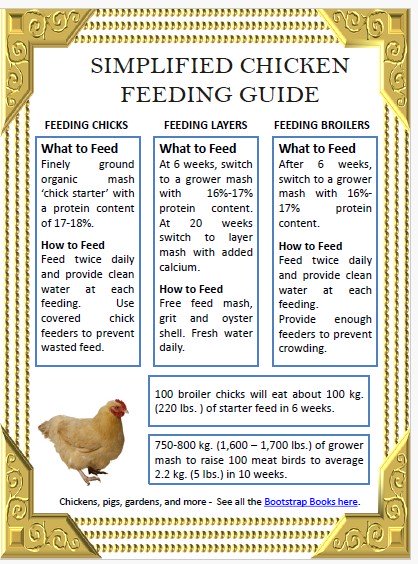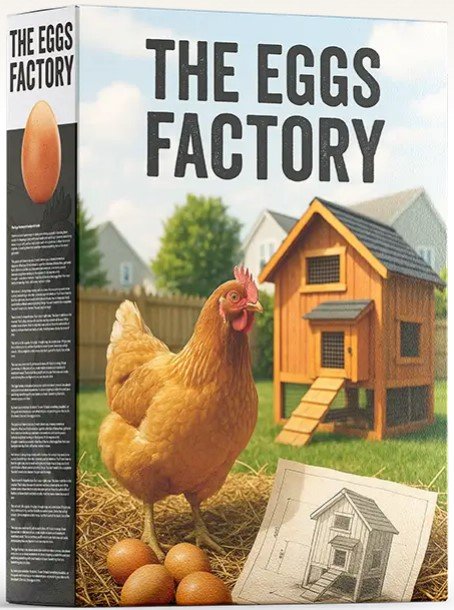How To Feed Chickens
There's a lot of advice out there about how to feed chickens on a small farm or land holding. I've seen some suggestions that appear way too complex for your typical small grower that just wants to raise some laying hens, or put a few birds in the freezer (and maybe sell some for a little cash). So here's a simplified 'how to feed chickens' approach that we've followed successfully for a lot of years. We routinely put a couple batches of 5-lb roasters in our freezer, with very few losses due to illness or predators. And we sell enough at a good price to pay all costs, so our chicken dinners are free! Here's how we do it. Let's Talk About Chicken Feed
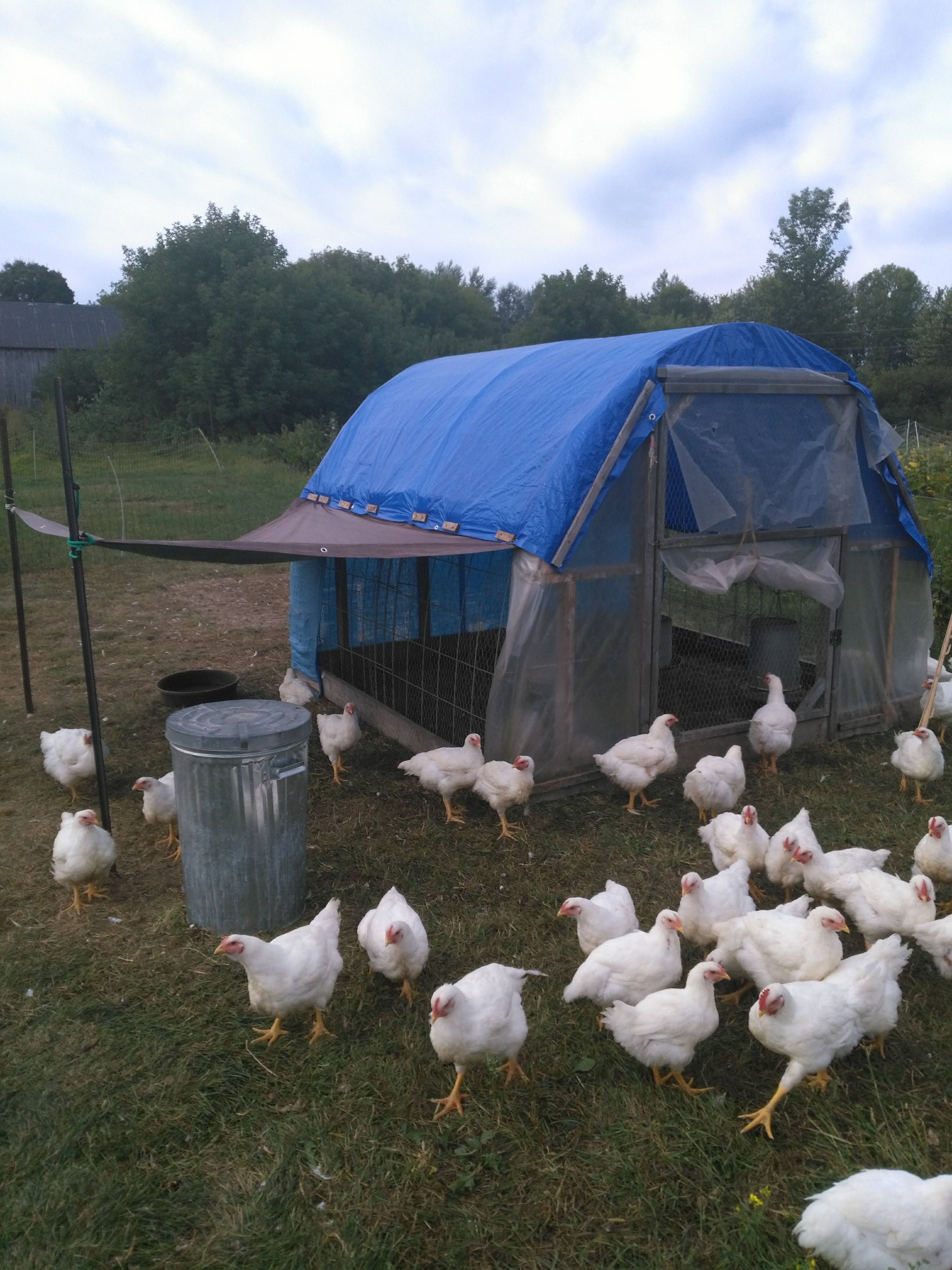 I keep a steel can of feed by my meat birds on pasture. 1 can per portable coop. I keep a steel can of feed by my meat birds on pasture. 1 can per portable coop.New Terra Farm has been raising chickens on organic feed for almost 20 years. We have used organic chick starter, organic layer mash, and organic chicken grower with great success. Let's define those terms: Chicken starter feed is a fine-ground mash (a mix of unprocessed grains) usually with supplemental vitamins and minerals added. 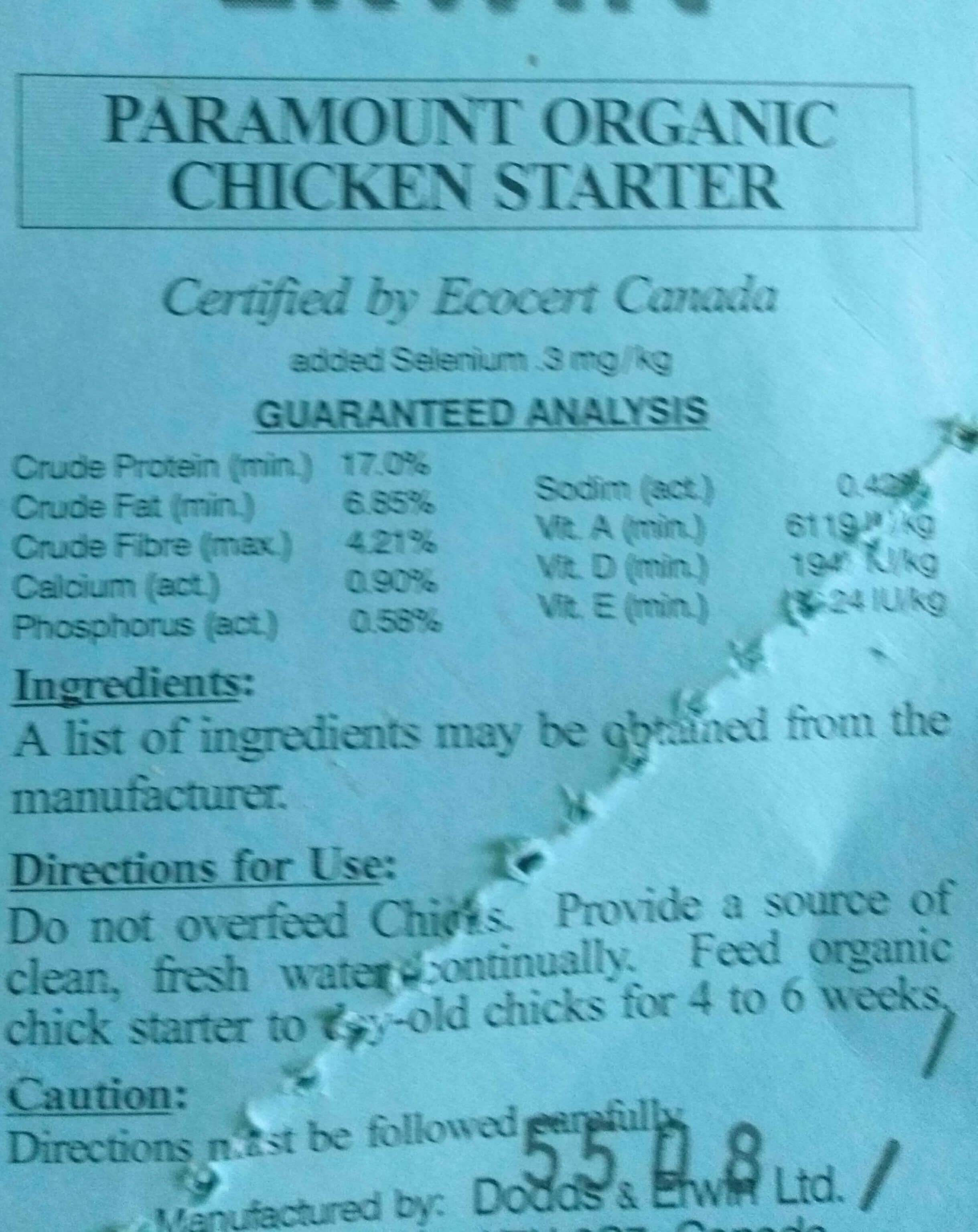 Typical organic chick starter nutritive analysis Typical organic chick starter nutritive analysisThis chick starter feed has 17% protein content and added vitamins and minerals including selenium, which is typically added to animal feed in areas where the soil is depleted of this element. I keep my laying hen chicks on starter feed for about 6 weeks. My meat birds (usually some variation of a Rock-Cornish cross) get starter feed for 4 weeks before switching to organic grower. Chicken grower usually has a somewhat lower protein content and is more coarsely ground. 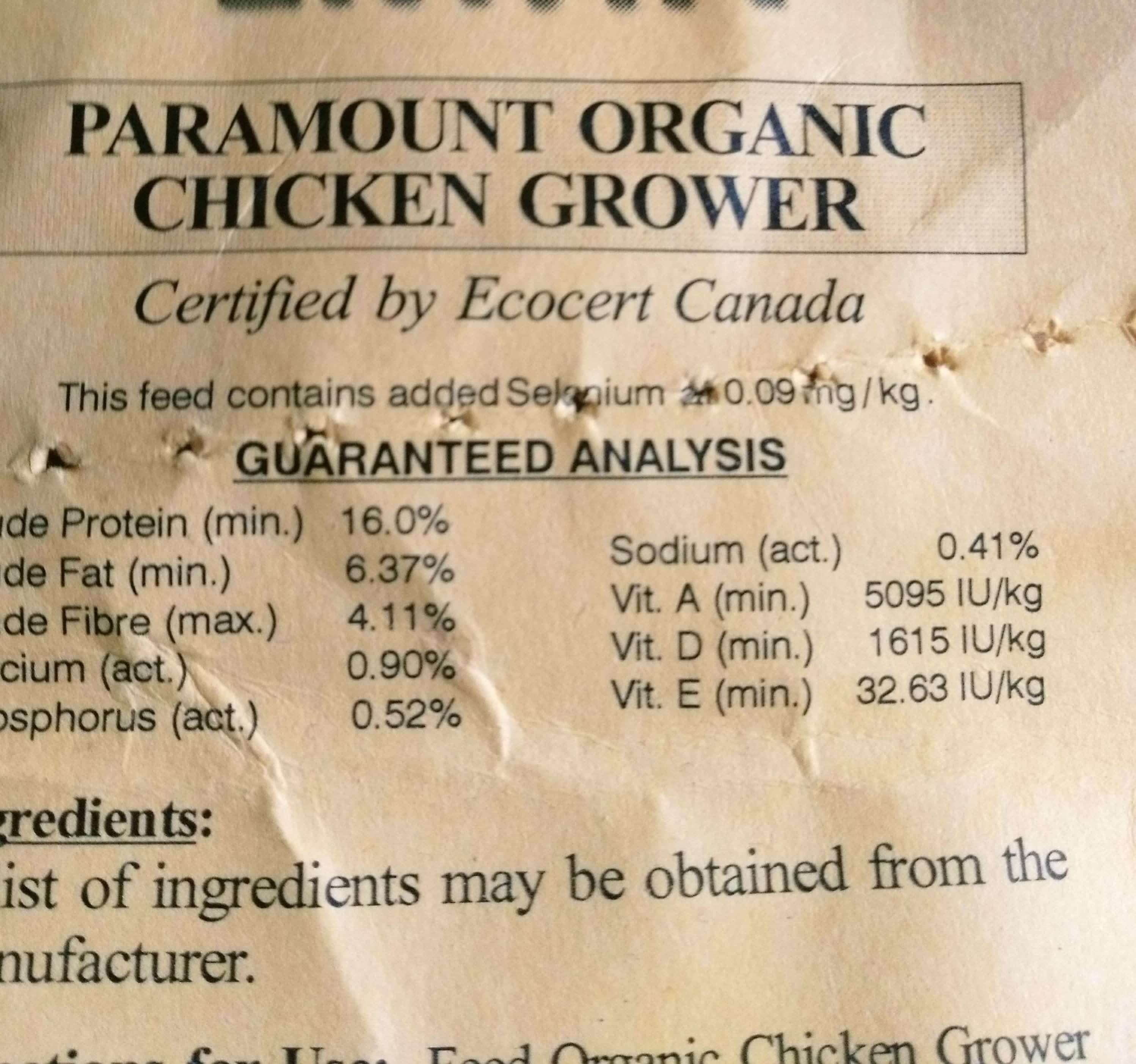 16% protein content with added vitamins and minerals 16% protein content with added vitamins and mineralsI've seen feeds with higher protein content but this level seems adequate to produce healthy birds fairly quickly. It takes me about 10 weeks on average to produce a 5-lb. roaster (my preferred size for the freezer and for sale). I've also seen some 'how to feed chicken' guides that recommend skipping grower and using a finisher ration following the chick starter. You certainly can, and the birds might finish a little quicker, but we haven't found it necessary. I'm happy with 'lower and slower' and fewer losses. How To Feed Laying Hens
We feed our laying hens a certified organic layer mash, with a 16% protein content. The main difference between 'grower' and 'layer' is the added calcium in the layer ration. 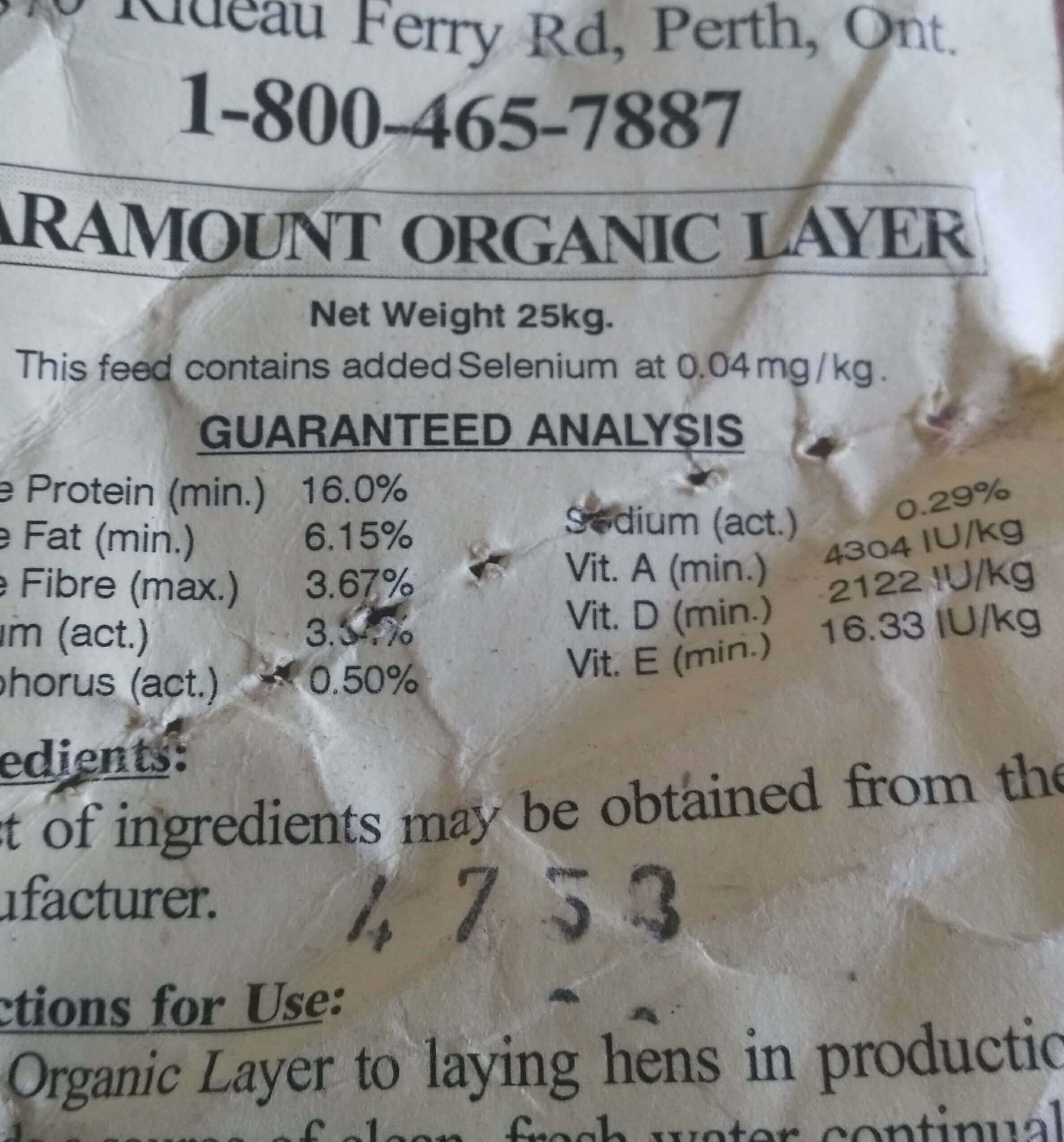 Calcium supplemented to 3.3% Calcium supplemented to 3.3%Note that all these feeds are considered complete feeds; however, we also provide our laying hens with free choice oyster shell for added calcium, and grit to assist digestion. In addition, all our chickens have access to the outdoors. Our laying hens free range around the place, and our meat birds are day-ranged in portable coops secure behind electric mesh fence. We keep at least one pen of meat birds near the garden as well so they can clean up waste we toss over the fence. How Often To Feed ChickensWe feed our chicks twice daily and make sure they have fresh water. We check their health as well, looking for signs of pasty butt or spraddle leg. We isolate and treat any ill birds we find. With our current set-up, this is a rare occurrence. We dip the beaks of the day-old chicks in the waterer when we first put them in the broody box. We also scatter a little feed on the newsprint we cover the shavings with for the first few days We also like to feed our meat birds twice daily, roughly 12 hours apart e.g. at 7 am and 7 pm in the summer. These birds are literally eating machines; when we tried free-feeding, we had a few cases of leg problems i.e. reduced mobility. Just from an animal welfare perspective, I prefer to take a week or two longer to get the birds up to size and give them a better life. I don't like having to cull birds for a preventable reason. We free-feed the laying hens in their coop, and replace their water daily. We have raised a variety of heritage breeds for our laying flock (Barred Rocks, Black Australorps, RI Reds, Silver Dorkings) and they don't seem to gorge on food. Chicken Feeding Equipment
Your day-old chicks will want small feeders and waterers that will fit in their brooding space. We use two-foot feeders with a 'roll' top and 1-gallon plastic waterers in the broody boxes. We also put a few pebbles in the waterers to make sure the little birdies don't get in. 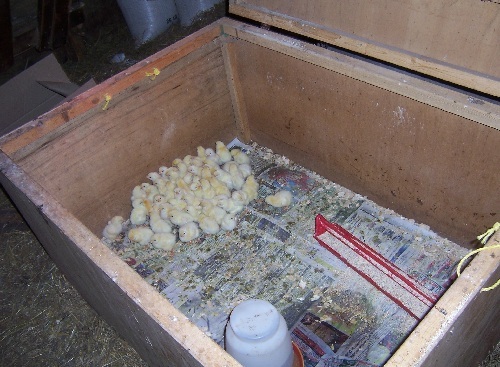 Day-olds in the broody box with roll-top feeder and 1-gallon waterer Day-olds in the broody box with roll-top feeder and 1-gallon watererI like hanging feeders for the laying hens and in my meat bird portable coops. 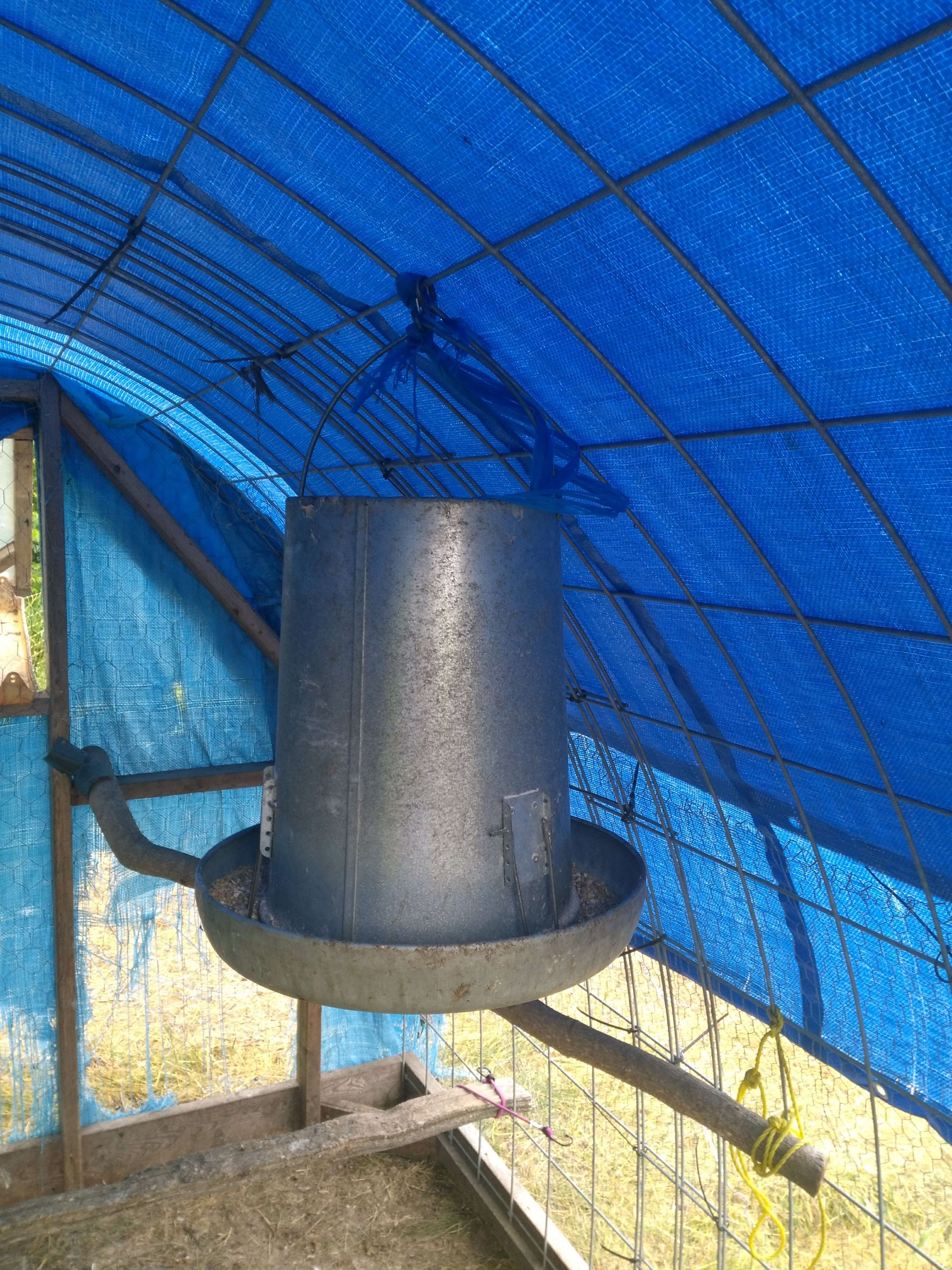 Hanging feeders save feed Hanging feeders save feedWe have a new flock of laying hens that we hatched out earlier this year. I use a little hanging feeder for them as well, in a separate coop from the 'grown-up' birds. 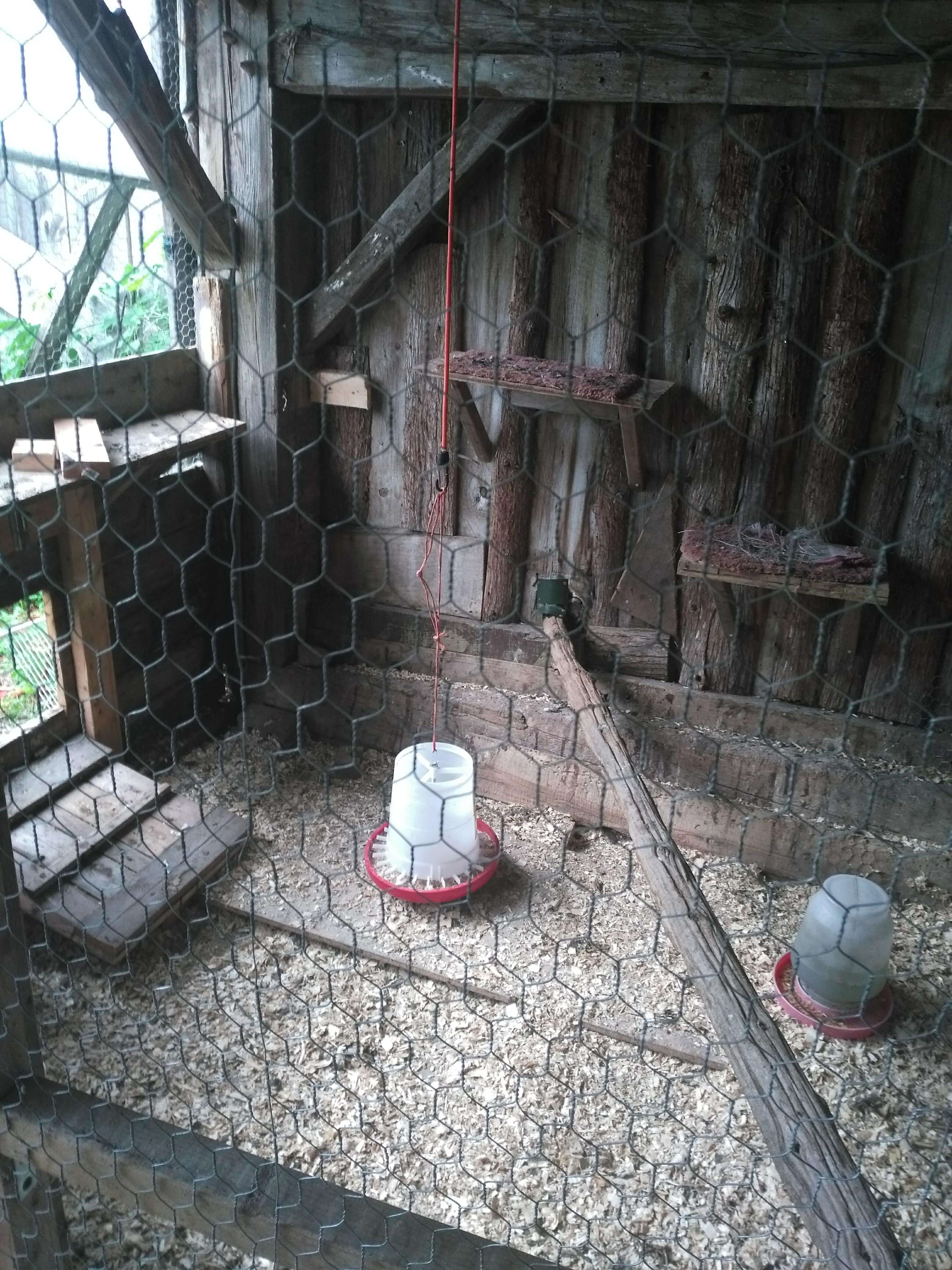 Plastic hanging feeder for the new laying birds. They enjoy the perch too. Plastic hanging feeder for the new laying birds. They enjoy the perch too.For the meat birds in the field, I built some long feeders from used eaves trough. I screwed on wooden ends to close them in and keep them stable. I also slit a section of surplus soaker hose and secured it over the sharp side of the feeder to prevent slashes during the mad rush of feeding time. 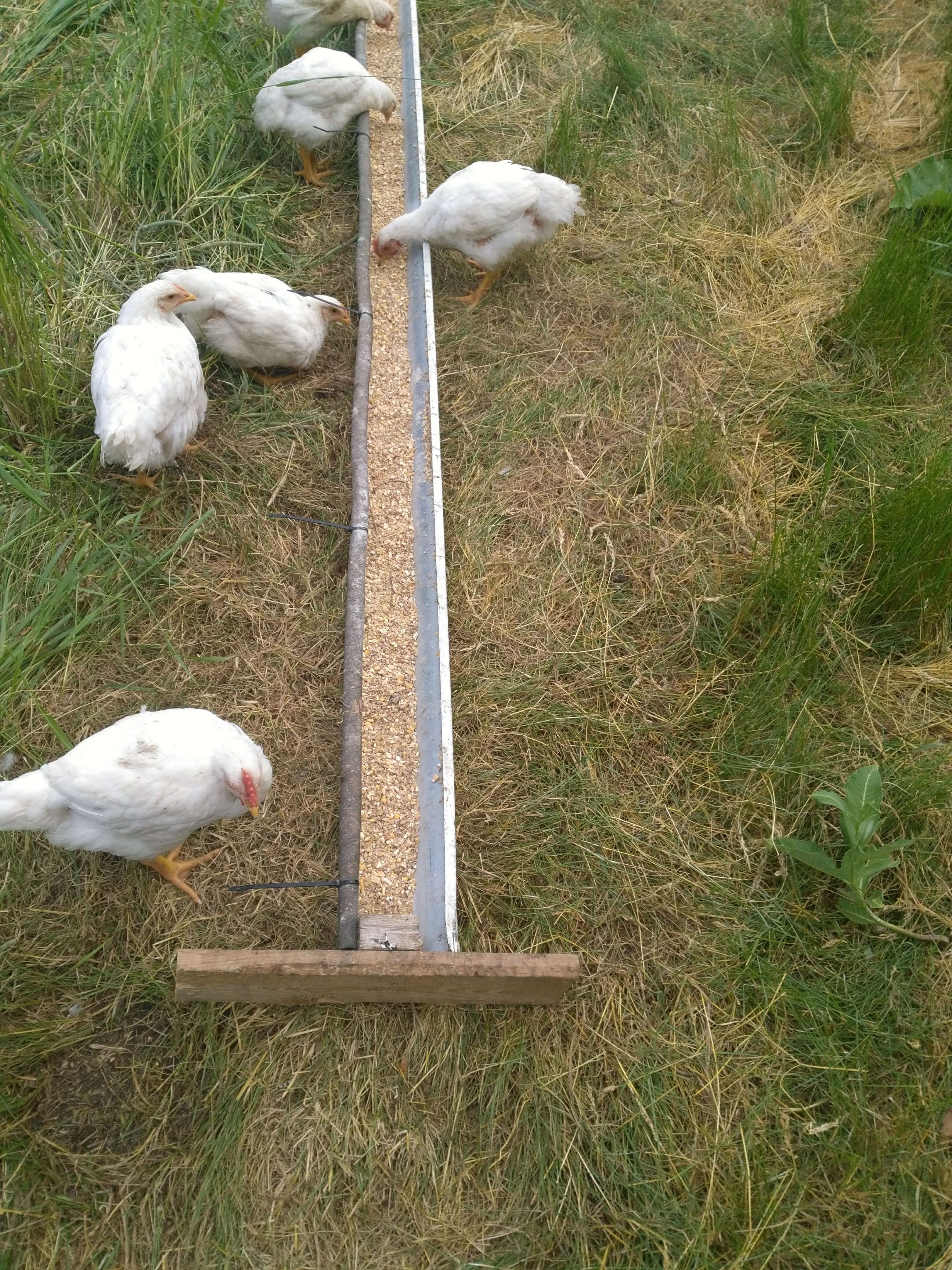 The long feeders are for the morning feeding outdoors, and the hanging feeders are for when they come in at night. We replace and refresh water at every feeding. This is critical in the heat of summer. A neighbor lost 75 big meat birds when their watering system failed during hot weather. 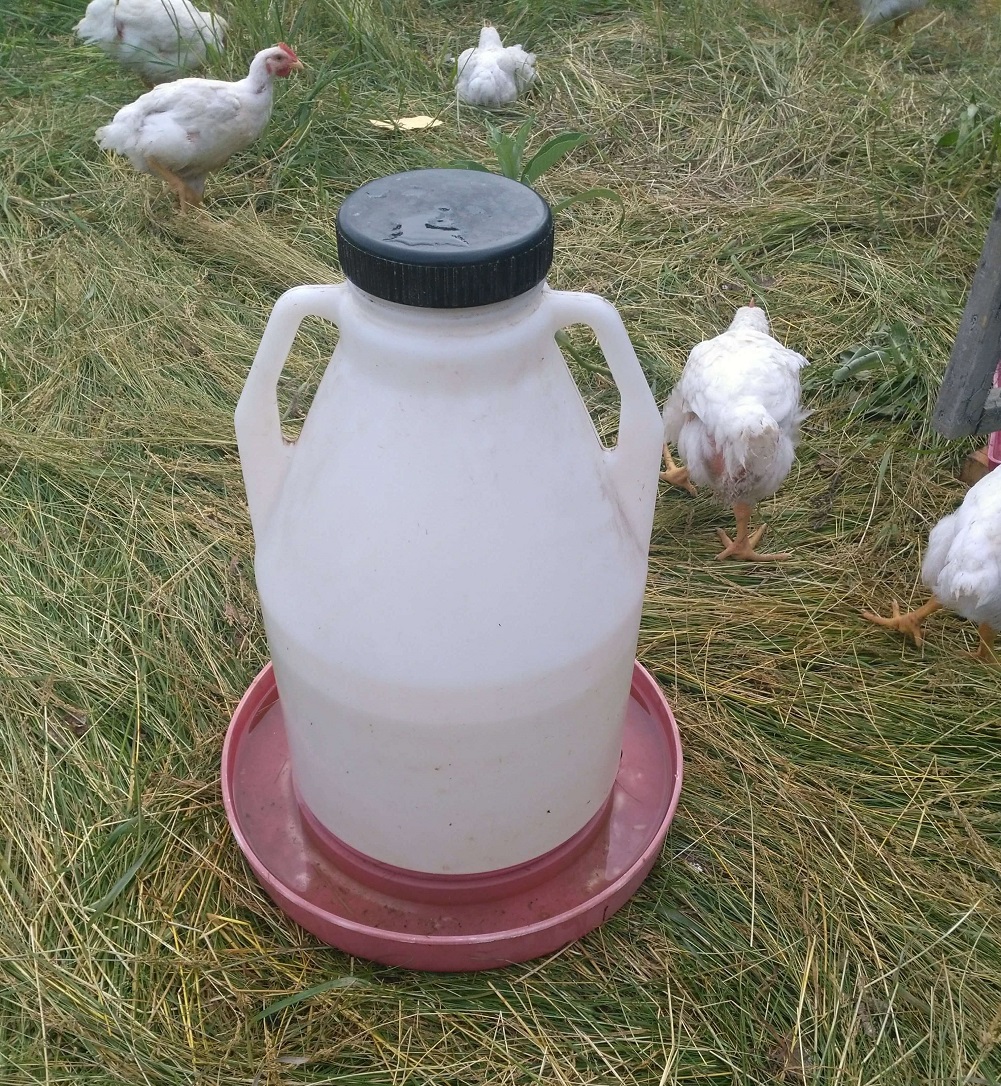 10-gallon waterer for the meat birds. 10-gallon waterer for the meat birds.How Much Feed?
Note: these numbers are estimates only, based on our records. Lots of factors, including breed of bird, weather, and access to supplementary feed - e.g. pasture - can affect performance.. 100 meat bird chicks will consume about 100 kg (220 lbs.) of starter feed in 6 weeks. We start out with about 8 oz of food divided among the broody boxes (we use four for 100 chicks). We increase that regularly as we see they are cleaning it up between feedings. We plan on about 750-800 kg (1,600-1700 lbs.) of grower to raise 100 birds to a 2.2 kg (5 lb) average weight in 10 weeks. All in, counting the cost of day-old chicks, transport, feed and bedding and processing at the abattoir, my birds cost me $2.90/lb. this year. I sell them locally for $4.50/lb., a nice mark-up of 55%. I charge higher prices for delivery to nearby towns, with a minimum of 5 birds per order. I arrange a day to deliver all my birdies at once to save transport cost. To look at it another way, if I sell 65 birds out of a batch of 100, that pays all costs. The 35 I keep for myself are free. You can get plans for all the above equipment and chicken coops in How To Raise Meat Chickens. And see all the Bootstrap Books here. Free One-Acre Farm Plan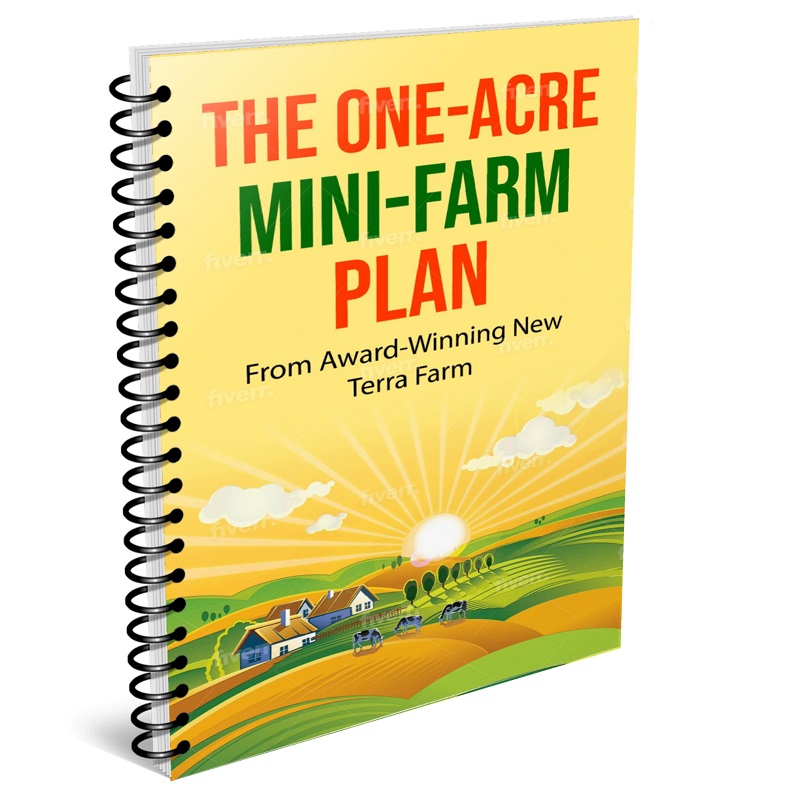 Get my FREE One-Acre Farm Plan and learn how to raise pigs, chickens and more, integrated with an organic market garden, to
make more money from your small property. Enter your best email and the Guide will be sent to you right away. Farm-Fresh Eggs From Your Backyard?One of my joys at New Terra Farm is going out to my chicken coop every day to collect fresh, organic eggs. If you’ve ever found yourself questioning the rising cost and declining quality of store-bought eggs, you’re not alone; and there’s a practical solution, even if you don't own a farm. I didn't write this one but it's a great resource anyway. If you can find 50 sq. ft. on your property this is a straightforward, hands-on guide for setting up a compact backyard chicken coop that can supply your household with a consistent flow of fresh, nutrient-rich eggs. It’s designed for people who value food security, self-sufficiency, and a healthier lifestyle, even if they have no prior experience with raising chickens. This system walks you through building a durable coop using common, affordable materials—typically for under $100. It’s low maintenance, fits in a small space (around 50 sq ft), and requires only a few minutes of attention each day. The guide includes detailed plans and practical tips for everything from predator-proofing to choosing quiet, productive breeds. If you’re looking to reclaim control over your food source, reduce grocery bills, or even create a modest income by selling excess eggs, The Eggs Factory offers a practical, community-tested solution to get started.
|
See something you like? Share!
Recent Articles
-
Farm grown reviews of products recommended by New Terra Farm
Dec 04, 25 06:26 AM
Find great farm and garden products in my farm grown reviews -
Best Chicken Coop and Accessories for Small Farms and Homesteads
Nov 30, 25 09:18 AM
Looking for the best chicken coop? Here are the top coops, accessories, nest boxes, and gear to build a safe, productive poultry setup. -
Community Supported Agriculture Marketing Ideas To Sell Out The Season
Nov 05, 25 05:18 AM
Authentic Community Supported Agriculture marketing ideas to grow loyalty, boost sign-ups, and sell out your CSA every year
